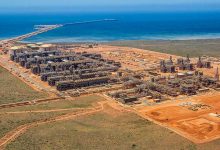Chevron Australia has announced that it has commenced the capture and storage of carbon dioxide at the company’s mammoth Gorgon gas project, a milestone labelled ‘better late than never’ after being beset with delays.
The Gorgon carbon capture project has been under development since 2009, with natural caverns being prepared under Barrow Island and was supposed to commence storing carbon emissions in 2016.
The carbon capture project has faced difficulties, and delays, relating to earlier installed valves and injection equipment that were found to be prone to leakage.
“We are pleased to reach the first milestone of safely starting the operation of the Gorgon carbon dioxide injection system, one of the world’s largest greenhouse gas mitigation projects ever undertaken by industry,” Chevron Australia’s managing director Al Williams said.
“This achievement is the result of strong collaboration across industry and governments and supports our objective of providing affordable, reliable and ever-cleaner energy essential to our modern lives.”
The project is expected to capture and ‘inject’ more than 100 million tonnes of carbon dioxide over the life of the project, representing around 40 per cent of the emissions directly produced by the Gorgon facility.
On an annual basis, the project is expected to capture up to 4 million tonnes of carbon dioxide once fully operational. But delays in getting the project up an running have seen emissions reductions achieved elsewhere in the Australian economy effectively wiped out by the ongoing emissions from the Gorgon project.

The CCS project will see carbon dioxide captured during the extraction of natural gas at the Gorgon project pumped and stored around 2km below ground in a reservoir under Barrow Island.
The Gorgon project is one of Australia’s largest natural gas extraction projects, and will produce around 15.6 million tonnes of liquified natural gas annually, and expects the carbon capture and storage project to likewise be one of the largest such projects operating in the world.
Carbon capture and storage has been promoted as a potential solution to greenhouse gas emissions, promising that countries can still exploit fossil fuel resources while eliminating their contribution to global warming.
But a lack of operational projects, and higher capital costs, have generated growing cynicism about the role of carbon capture and storage in reducing global emissions, and whether it is simply serves as a delaying tactic to prolong the life of the coal sector, particularly in the face of low cost renewable energy technologies.
The total cost of the Gorgon carbon capture project is expected to exceed $2.5 billion, with the project receiving $60 million in federal government funding under the Low Emissions Technology Demonstration Fund.
Chevron will be required to undertake ongoing monitoring of the underground reservoir, including seismic surveys, to maintain the integrity of the naturally formed carbon storage site.
The Australia Institute has highlighted the delays in the commencement of carbon capture activities, with the project effectively in breach of its development approvals which stated carbon capture was to commence in 2016.
“It is better late than never for taxpayers, having funded this project to the tune of $60 million dollars, to support Chevron to sequester emissions as it is legally required to do so under its development approval,” TAI’s climate and energy program director Richie Merzian said.
“Given the lengthy delays and excuses Chevron has offered to date regarding the CCS project, we will watch with interest when the project gets ramped up and is operational as promised,”
“Chevron is still in emission-reduction debt for the last three years of pollution — against legal requirements. This carbon debt is equivalent to the annual emissions of 12 Pacific island states combined.”
Australia’s greenhouse gas emissions have been driven higher as a result of the growth in LNG production, with fugitive emissions from the oil and gas sector more than doubling over the last five years.







